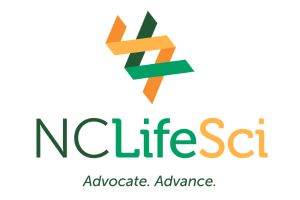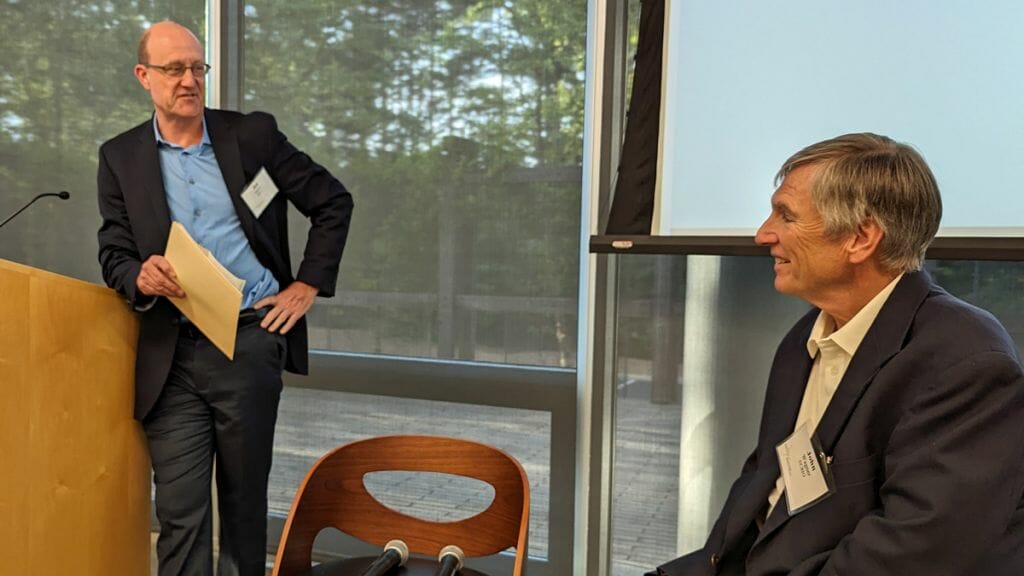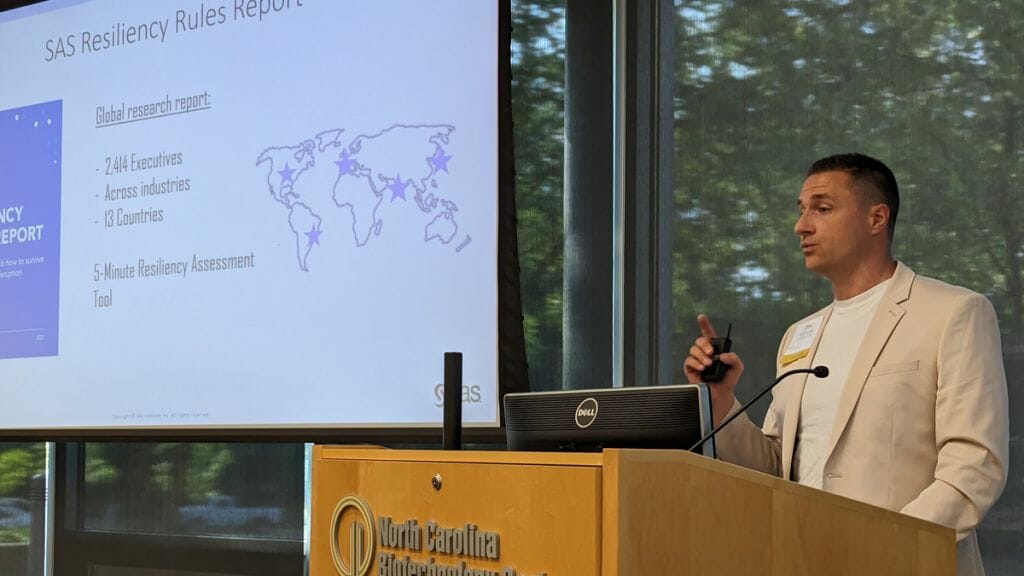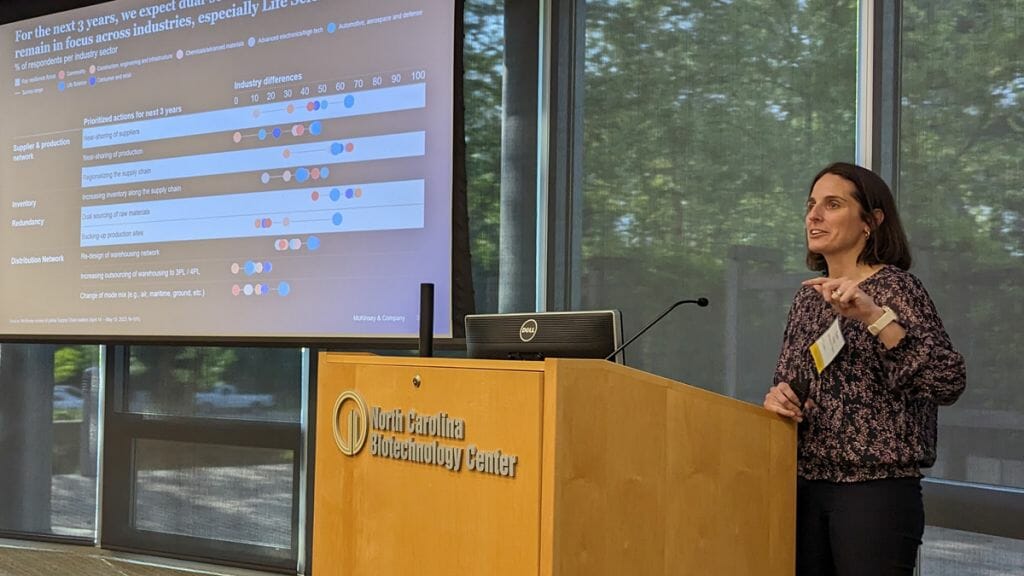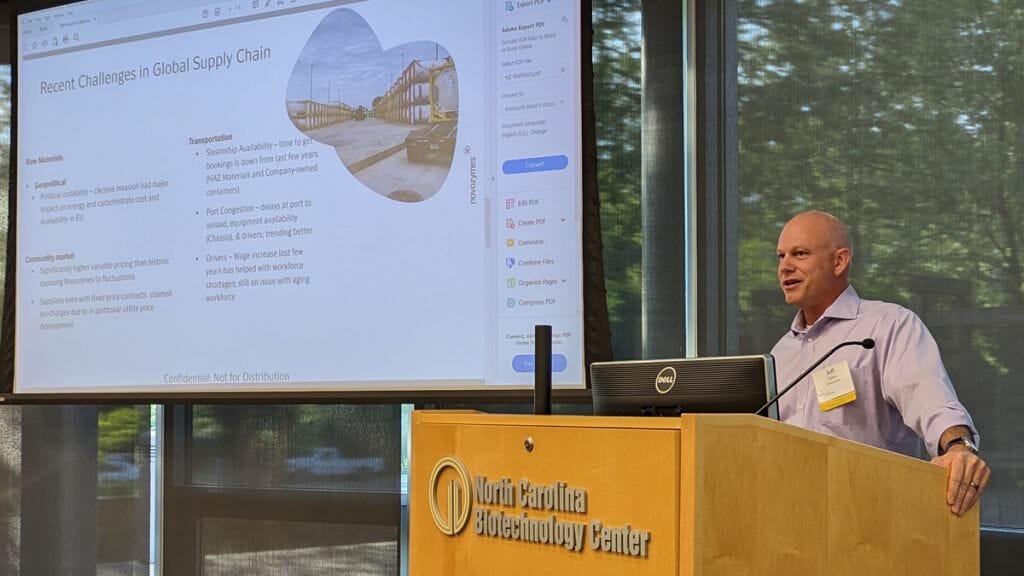BMF explores resiliency, honors Wagner
At its June 14 meeting at the NC Biotechnology Center, the NCBIO Biotech Manufacturers Forum learned lessons of resiliency presented by McKinsey & Co., Novozymes and SAS and recognized John Wagner’s eight years of service to the group as BMF program manager. Wagner will retire from the role this summer.
Wagner updated members on recent issues the organization is focusing on, including a proposed revamp of the Biomanufacturing Training and Education Center at NCSU called BTEC 2.0, a new logo and website for NCBioImpact and the 2023 Life Sciences Workforce Trends Report released at the recent BIO convention in Boston.
Gunter, BMF Chairman Jon Tucker and NCBIO Chairman Neal Fowler also recognized the contributions and work of BMF Program Director John Wagner, who is retiring. Gunter and Tucker are seeking a successor, and Wagner said he will continue to assist with BMF programming until one is found.
The presentations focused on building resiliency within organization, and the featured speakers were
- Alex Maiersperger, global health care principal, SAS Institute;
- Tacy Foster, partner, McKinsey & Co.; and
- Jeff Stine, senior manager supply chain operations, Novozymes.
SAS Institute’s five rules
Maiersperger shared a SAS global survey of executives across five industries (financial services, retailing, consumer-goods manufacturing, health care and life sciences and government) looking at resiliency and said that the No. 1 takeaway was that resilient organizations are made up of resilient people.
“Resilient organizations have leaders that invest in training and technology and have external views of the world that help shape decisions and allow for pivots and tweaks to their strategy when faced with all the pressure of modern-day challenges," he said.
While 97% of executives responding said resiliency was very or somewhat important, only 47% said their own organizations were resilient. High resiliency organizations valued curiosity eight times more than low organizations, and high resiliency organizations were significantly more likely to support employee resource groups and mentorship programs.
Survey respondents agreed that investing in internal resiliency better prepares companies for unpredictable events, strengthens their business performance, allows for much faster restoration of technical function and engenders stronger customer confidence and trust, Maiersperger said.
From the survey, SAS was able to glean five rules of resiliency:
- Speed and agility: Adapt to changing market conditions quickly
- Equity and responsibility: Apply ethical standards while developing and using transformative technologies
- Curiosity: Harness the power of exploration to drive insights that fuel innovation and impact
- Innovation: Accelerate advances through data-led insights
- Data culture and literacy: Build a data-driven focus that instills data literacy across the organization
That SAS Resiliency Rules Report is available to download at https://blogs.sas.com/content/resiliency/.
McKinsey & Co.’s four buckets
“The McKinsey Global Institute ran a report in 2020 and found that we all should expect an event that interrupts our supply chain for more than two months every five years,” Foster said.
“All of our research shows companies that are resilient continue to be resilient and continue to grow.”
Foster said the actions companies were taking to become more resilient generally fell into four “buckets”:
- Network changes: Examples include moving to more local suppliers, backing up the supply chain, increasing inventory, changing the distribution network and changing shipping lanes.
- Supply-chain planning: Getting better visibility into the supply chain through information technology.
- Digitization: Building a digital model of the company to use to test various scenarios.
- Supply-chain risk management: Changing company culture to be able to respond quickly to a crisis.
Foster said that that there is no one thing that a company can do to be more resilient and that companies that take multiple actions to secure their supply chains are the ones that become the most resilient.
Novozymes’s balancing act
Novozymes manufactures globally, and a significant volume of its products can be made in multiple locations, Stine said. While that allows for capacity balancing and the ability to take advantage of local conditions, there are still some sites that have unique capabilities that can limit flexibility. Because of this, multisite qualification for a new product starts very early in its development.
“Knowing ahead of time which key sites we want to manufacture our products as this gives us a faster response,” he said. “We have supply routes going from Denmark to Brazil, Denmark to India; we’ll also do China to North Carolina, North Carolina or Omaha to Brazil. It allows us to move products as we need to from one manufacturing site to the other across the regions.”
Sourcing for supply resiliency is key to Novozymes, Stine said. The company ensures that at least 80% of the materials it uses are available from two or more sources. The company increased levels of safety stock during the pandemic and created a crisis-management model of the organization that is used to test the effects of different scenarios.
SAS Institute’s five rules
Maiersperger shared a SAS global survey of executives across five industries (financial services, retailing, consumer-goods manufacturing, health care and life sciences and government) looking at resiliency and said that the No. 1 takeaway was that resilient organizations are made up of resilient people.
“Resilient organizations have leaders that invest in training and technology and have external views of the world that help shape decisions and allow for pivots and tweaks to their strategy when faced with all the pressure of modern-day challenges," he said.
While 97% of executives responding said resiliency was very or somewhat important, only 47% said their own organizations were resilient. High resiliency organizations valued curiosity eight times more than low organizations, and high resiliency organizations were significantly more likely to support employee resource groups and mentorship programs.
Survey respondents agreed that investing in internal resiliency better prepares companies for unpredictable events, strengthens their business performance, allows for much faster restoration of technical function and engenders stronger customer confidence and trust, Maiersperger said.
From the survey, SAS was able to glean five rules of resiliency:
- Speed and agility: Adapt to changing market conditions quickly
- Equity and responsibility: Apply ethical standards while developing and using transformative technologies
- Curiosity: Harness the power of exploration to drive insights that fuel innovation and impact
- Innovation: Accelerate advances through data-led insights
- Data culture and literacy: Build a data-driven focus that instills data literacy across the organization
That SAS Resiliency Rules Report is available to download at https://blogs.sas.com/content/resiliency/.
McKinsey & Co.’s four buckets
“The McKinsey Global Institute ran a report in 2020 and found that we all should expect an event that interrupts our supply chain for more than two months every five years,” Foster said.
“All of our research shows companies that are resilient continue to be resilient and continue to grow.”
Foster said the actions companies were taking to become more resilient generally fell into four “buckets”:
- Network changes: Examples include moving to more local suppliers, backing up the supply chain, increasing inventory, changing the distribution network and changing shipping lanes.
- Supply-chain planning: Getting better visibility into the supply chain through information technology.
- Digitization: Building a digital model of the company to use to test various scenarios.
- Supply-chain risk management: Changing company culture to be able to respond quickly to a crisis.
Foster said that that there is no one thing that a company can do to be more resilient and that companies that take multiple actions to secure their supply chains are the ones that become the most resilient.
Novozymes’s balancing act
Novozymes manufactures globally, and a significant volume of its products can be made in multiple locations, Stine said. While that allows for capacity balancing and the ability to take advantage of local conditions, there are still some sites that have unique capabilities that can limit flexibility. Because of this, multisite qualification for a new product starts very early in its development.
“Knowing ahead of time which key sites we want to manufacture our products as this gives us a faster response,” he said. “We have supply routes going from Denmark to Brazil, Denmark to India; we’ll also do China to North Carolina, North Carolina or Omaha to Brazil. It allows us to move products as we need to from one manufacturing site to the other across the regions.”
Sourcing for supply resiliency is key to Novozymes, Stine said. The company ensures that at least 80% of the materials it uses are available from two or more sources. The company increased levels of safety stock during the pandemic and created a crisis-management model of the organization that is used to test the effects of different scenarios.
